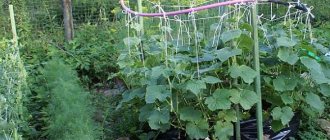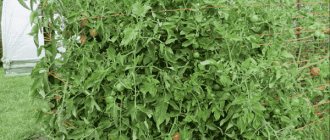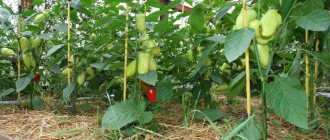Planting blueberries in the fall: when to plant
Planting blueberries in autumn
Wild blueberries grow in forests of moderately cold climates, that is, closer to the northern regions of Russia. But in practice, garden blueberries are also grown, which are usually grown in individual bushes or even plantations, provided that there is enough free land. If the gardener calculated everything correctly and followed all the planting rules, blueberries will please you for 2-3 years of their existence.
The timing of planting seedlings depends on the characteristics of the plant itself, since the trunk can stretch and reach 1.2 meters in height. It is worth noting that the root system looks fibrous and does not have hairs, and thus it is quite difficult to obtain nutrition from the soil; because of this, the process of forming the above-ground part takes a long time.
The secret for the gardener is to plant blueberries in the fall or spring so that they become established in the area. This choice is determined so that the seedlings can adapt and easily withstand frost. In the spring it is necessary to plant before the buds appear. Most people prefer the autumn planting period, since there is no need to take excessive care during the summer-spring period, when the bushes may suffer from insects that interfere with their adaptation period.
Frequently asked questions about growing blueberries in the Moscow region:
When does blueberry bloom in the Moscow region?
In the climate near Moscow, blueberries bloom at the end of May. The buds of the inflorescences are white or pale pink.
When do blueberries ripen in the Moscow region?
Blueberries in the Moscow region begin to ripen by mid-July, and harvesting lasts 3-4 weeks; there are years when harvesting continues until frost. Despite their compact shape, blueberry plants are quite productive. Up to 5-6 kg of berries are often harvested from one bush.
Is it necessary to cover blueberries for the winter in the Moscow region?
Blueberries are a winter-hardy plant - they can withstand frosts of more than 25 degrees, and some specimens up to -35 degrees. These characteristics are perfect for the Moscow region climate, however, during periods of cold and snowless winters, blueberry bushes may freeze.
During these periods, blueberry branches must be covered. To do this, metal arcs are installed on top of the plants, and burlap is spread. It is recommended to cover the burlap with pine branches and cover it with snow.
When to plant blueberries in the Moscow region?
Blueberries are planted in the Moscow region in spring or autumn, but spring is more preferable, since the risk of plants being damaged by frost is minimal. You can start planting in mid-April, when the surrounding air warms up to 12-16 degrees.
What soil acidity is needed for blueberries?
Blueberries grow well in areas with acidic soil. The reaction should be 3.5 – 5 pH. However, not all soils in the Moscow region have such a reaction. If the pH is lower, the soil must be adjusted to the appropriate level. To do this, prepare a solution of 100 g of vinegar per 10 liters of water or pour in a solution of citric acid 2 tsp per 8 liters of water.
How often do you acidify blueberries?
It is recommended to acidify the soil in areas where blueberries grow once every 3-4 years.
Planting blueberries in autumn: preparation
Planting blueberries in autumn: preparation
Before planting, it is necessary to carry out preparatory measures. This means that you need to calculate the period that will be enough to prepare and get used to the upcoming frosts. In the fall, seedlings are planted that were grown from a mature bush over the winter or seedlings that are in flowerpots are used.
Time to plant blueberries in autumn
Time to plant blueberries in autumn
For a timely planting date, you should choose a warm autumn day towards the end of September or the beginning of October. The calculation also depends on the climatic region in which the plantation is located and the first cold weather should be approximately 30 days below zero. This period is considered the most optimal for normal plant adaptation.
Preparing for landing
Blueberries are not too picky about the sun, but it is advisable to plant them where there will be enough sun for growth. To select the right site, follow the following instructions: • there should be no through winds; • flat territory; • no groundwater at the level of the root system; • do not plant next to trees that will darken the seedlings.
The soil may have an acidic environment, but within 4 Ph. The soil should be light and loose, which will allow water to be quickly absorbed and promote active growth of the entire root system.
Soil preparation depends on the quality and properties of the soil. If there is light loam and groundwater at a depth of 2 meters, then you should dig holes up to 40 cm deep. If the soil is fairly clayey, then you should dig a hole about 10 cm, sprinkle with sand or sawdust, and then plant the plant. This way, the roots of the plant will be at ground level. If there is sand and peat, then the hole becomes deeper and reaches 50 cm, and up to one meter wide. An acidic mixture of peat, sawdust, pine needles and sand is backfilled, and then the seedling is planted and sprinkled with the rest of the soil.
To increase the acidity of a certain area of land, you can add dry sulfur powder or a solution of citric and oxalic acids.
What kind of soil does blueberry like?
It has long been known that this plant is not the most demanding of soil composition. It cannot tolerate stagnant water, but if planted in sand, on the contrary, it will suffer from moisture deficiency.
The best soils for blueberries are light and acidic. Peat bogs and sandy loam substrates are comfortable for it, and rotted leaf litter serves to improve the water regime and increase the fertility of the land.
Why are blueberries so sensitive to acidic soil? Due to the special structure of its root system. You will not find small hairs on blueberry roots. For other plants, they serve as a means of providing water and various nutrients. For blueberries, mycorrhiza became such a guide. This is the name given to microfungi that can develop exclusively in an acidic environment.
High peat for blueberries becomes a more productive mixture when bark, needles, branches, cones or sand (10%) are added to it. Lowland peat is mixed with the other components so that its share is at least 40%.
Planting blueberries in autumn: choosing seedlings
Selection of seedlings
Seedlings for planting can be purchased in specialized stores. The most profitable warrant is to purchase 3 bushes, but you should pay attention to the variety of berries, taking into account the climate in your region. For example, for Siberia it is necessary to choose varieties that can survive fairly low temperatures.
Seedlings that are in containers must be watered when planting, thereby preparing them for further planting in the ground. In this case, the roots are hidden, you need to be careful when pulling out a lump of earth. When planting, they must be straightened and directed downwards so that they occupy all the space in the previously prepared hole.
Planting in the autumn During the autumn planting, you need to pay special attention to the plant, since on the eve of winter it must have time to go through an adaptation period. It depends on how correctly the landing was done.
If the seedlings are of medium size, then prepare a hole 50 by 50 cm. For lands that are susceptible to acidification, you need to choose a special planting method, using a 200 liter plastic barrel. We place it at the bottom of the prepared hole, then add drainage (10-20 cm), and the next layer is a nutrient mixture. The next step is to plant the seedling in the hole, then season it with nutritious soil and compact it. A distance of 1.5 m - 2 m should be left between the bushes, since the roots do not grow down, but wide.
We advise you to mulch the soil after watering, and for this you need to choose an acidic filling: pine bark, peat, rotted sawdust of pine needles. This mixture will protect the soil from freezing, moisture loss and the appearance of weeds.
Shrub care
Transplanted blueberries will need proper care. It is as follows:
- Periodic watering. Depending on weather conditions, the shrub needs to be watered several times a week in spring and summer. In autumn, soil moisture can be eliminated.
- Mulching the earth. Rotted sawdust and pine needles are used as mulch.
- Feeding. In spring, mineral fertilizers are applied to the bush.
- Pruning. Pruning is done in the spring, before the buds ripen. The procedure is carried out a year after planting the seedling.
- Spraying leaves. Moisturizing the leaves of the bush should be done on hot days in the evening.
It is recommended to carry out gardening work comprehensively and strictly observe its frequency.
Proper care in autumn
If we talk about care, then for autumn planting it is required several times less than in the spring-summer period. But it is worth paying maximum attention to fertilizing and watering.
Always check the soil moisture during the adaptation period - it should be moderately moist. The frequency of watering depends on what the weather is like outside the window. If it is constantly raining and cloudy, you should not water it again, so as not to flood the roots with water. If the weather is dry, then watering should be daily and about 10 liters of water for each bush.
In autumn, when there is a lack of minerals, it is customary to add potassium nitrate and potassium sulfate. The granules are poured into the soil and dug up. You should avoid using nitrogen-containing mixtures in the fall and wait until spring, when they will be needed.
In autumn, during care, you should trim the planted bushes: cut them out completely if there are weak and damaged branches, and cut good branches in half.
Sheltering for the winter
Shelter for the winter
If you decide to grow blueberries, then you should think about how to protect them during the winter. First of all, it must be covered, regardless of the variety.
Preparation for winter begins in the autumn after planting and consists of several stages: • First, it is necessary to provide abundant watering - thus, we create the necessary amount of moisture for the winter period, which will nourish our plants.
• Next you need to add mulch to the soil. Thanks to this, we retain heat and moisture in the soil, and roots from freezing.
• The next step is to acidify the soil, but this must be done in the warm fall. If the weather still doesn’t work out, then this procedure is postponed until spring.
• Bushes are pruned every autumn. In the spring, the bushes grow more actively, and in winter they are not susceptible to freezing if pruned correctly.
The covering material must be dense and breathable, otherwise the roots will begin to rot. Agrofibre or burlap is best suited for this.
Each plant should be tied with material, using nylon threads and secured with additional oppression.
Adult shrubs must be bent to the ground in advance so that they can be lowered and not damaged during tying. If the branches lie on the ground without help, then they are covered with material, tied and boards are placed on top for the best fixation.
When snow has fallen and the temperature remains below zero, you can additionally make snow decks on top of the covered blueberry bushes. This will keep the berries from freezing in winter. Thus, preparations for winter are over!
When spring comes, snow must be removed in advance before the thaw period begins. Then all additional flooring is removed when the temperature stabilizes above 0 degrees.
The main mistakes when organizing blueberry wintering
So, we will now examine in more detail what mistakes are most common among amateurs and experienced gardeners. Many people are of the opinion that when planting blueberries in the fall, you don’t need to take any care of them, and in this they are very mistaken. List of common misconceptions when growing blueberries: • Too much water. Overflow should not be allowed to occur before the winter period. If the water is not absorbed into the soil, then it will freeze and the bush will die. • Large amounts of acid. If you overdo it during the autumn acidification period, the acidity of the soil will increase significantly, thus the blueberry bushes will spend the winter period under stress and have a negative impact on growth. • Loosening too deep. In the autumn, loosening within 3 cm is permissible; if you loosen deeper, there is a possibility of damaging the root system.
In conclusion, I would like to note that despite the fact that care is quite simple, it is very labor-intensive, since it is a system of agrotechnical techniques.
How you planted in the fall and prepared for the cold depends on the future life of the plant and its preparation for spring bud formation. Planting blueberries in autumn
How else can you grow blueberries?
For planting and breeding blueberries, you can use not only seedlings. To propagate the plant we use the following methods:
Seeds
This breeding method is the most labor-intensive. In the fall, we obtain seeds from ripened berries, dry them and sow them in the soil for seedlings to grow. The most suitable conditions for growing seeds:
- air temperature within 23-25°C;
- air humidity at 40%.
After planting, regularly water the seeds, loosen the soil and remove emerging weeds.
Cuttings
We cut cuttings in the fall after the bushes have shed their leaves. For propagation we use cuttings 8-15 cm in size, which are located at the root. We plant them in a peat-sand mixture (1:3) at an angle.
You may be interested in:
How to transplant currants to a new place in the fall Autumn time has come and novice gardeners are wondering whether it is worth replanting currant bushes in the fall? When is this...Read more...











